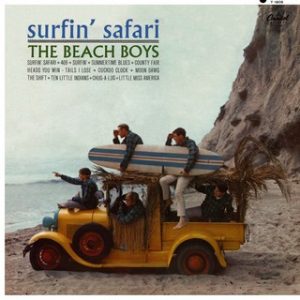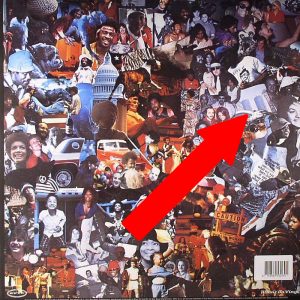 There has always been a lot of emphasis on album cover art – and why not? Visuals are often as an important part of the band’s image as the music contained within. Some album covers have become as iconic as the music (Pink Floyd – Dark Side of the Moon), some far more famous than the music inside (The Velvet Underground & Nico) and some are interesting but make absolutely no sense (Scorpions – Animal Magnetism).
There has always been a lot of emphasis on album cover art – and why not? Visuals are often as an important part of the band’s image as the music contained within. Some album covers have become as iconic as the music (Pink Floyd – Dark Side of the Moon), some far more famous than the music inside (The Velvet Underground & Nico) and some are interesting but make absolutely no sense (Scorpions – Animal Magnetism).
That said, at the risk of sounding like a crabby-ass old hermit, the golden age of classic album art is gone. Sure, album art websites try to convince us to believe that Katy Perry, Amy Winehouse and Lady Gaga album covers rank among the greats; trust me, they don’t. It’s all over but the crying, so let’s visit a few album covers that have some connection to something else. Or not.
Pink Floyd and Cinderella


Actually, the image in question isn’t the cover – it’s found inside the gatefold of the Floyd’s 1975 opus, Wish You Were Here. The front, as we all know, is the man shaking hands with the burning man, taken at a studio lot in California. It was designed by Storm Thorgerson, who along with Aubrey Powell founded Hipgnosis, who created a bunch of covers for quirky British bands – T. Rex, The Nice and UFO – before hitting pay dirt with the aforementioned Pink Floyd, which brought their work into the spotlight. (And then started attracting more mainstream bands – Led Zeppelin, Bad Company and Styx, among others.)
But come back inside to see a small picture of a man diving into a strange-looking body of water without causing ripples. (It was actually a shot of a man performing an underwater handstand.) Though no location was given, the shot took place in California’s Mono Lake, which is inland, quite close to the Nevada border. Mono Lake is in an endorheic basin (that’s for all the geology geeks out there) that produces high levels of salt and alkaline. Its distinctive (and prehistoric-looking) limestone tufa towers are its most iconic feature.
But Floyd’s album isn’t the only time Mono Lake turned up in the rock world; cue 1988, a time when big-hair pop/metal/rock bands roamed the earth. Cinderella’s “Don’t Know What You Got (Till It’s Gone)” (#12 on US Hot 100) used Mono Lake as the backdrop for its video of the song; once again, the tufa towers prominent. Not sure how many viewers recognized the location from their crazy uncle’s vinyl collection.
The Beach Boys and The Carpenters
In America, if you were young and bursting with musical talent in the early/mid 1960s, it seemed that California (particularly Los Angeles) was the place to be. Some were fortunate to be born and raised there (The Beach Boys), while others (The Carpenters) migrated from the much more-dreary city of New Haven, CT. (At least they weren’t from Meriden – a little Connecticut humor for you!) No matter, everybody was out there having fun, in the warm California sun.

Although they weren’t the first to combine surfing and rock, The Beach Boys got the nation amped on the idea of riding some tasty waves. (Even though drummer Dennis Wilson was the only member who actually hung ten.) Therefore, it was a natural that their album covers would feature America’s band with surfboards and a woodie. (Take your mind out of the gutter – according to the lord of knowledge – Wikipedia – a woodie is a car body style with rear bodywork constructed of wood framework with infill wood panels.) So, it makes all the sense in the world that cover of The Beach Boys debut album (called LPs in those days), Surfin’ Safari, was taken in a hot surfing spot, Paradise Cove.

In 1970, when pop duo The Carpenters were recording their sophomore effort, Close to You, a quick cover shot was required. It was so rushed, that in fact, the band had to get back to the recording studio that night to continue recording the album named after its #1 hit title track. Quick fix – they took a jaunt down to Lunada Bay (close to Paradise Cove – though maybe not by L.A. standards) for the cover shot for the duo’s first hit album. Oddly enough, they didn’t look worse for the wear considering they traversed the rugged the trail down to the water.
Lunada Bay was also in the news this decade: Its notorious local “surf gang” claimed exclusive use of its legendary waves, keeping outsiders out by threats and intimidation: Throwing rocks at interlopers, slashing the tires of outsiders and ganging up on those who did manage to get their boards in the water. The battle rages on.
Chicago and Wilco (with a little help from Sly and the Family Stone thrown in for good measure)

A Chicago landmark has been used by two bands – Chicago and Wilco. Aside from that fact that both bands were formed in The Windy City, there is little else they have in common. Wilco, the Jeff Tweety-fronted band, formed from the ashes of an early critical favorite (but commercially unsuccessful) band, the alt-country (the fact that I’m even typing “alt-country” makes me sound like a douchebag hipster) Uncle Tupelo (which itself was a product of another failure, The Primitives). That’s all I can say about Wilco.
OK, another thing Chicago and Wilco have in common – someday Wilco will join their horny homeboys in the vaunted Rock and Roll Hall of Fame. That’s because Wilco is a critic’s wet dream – especially in light of their Yankee Foxtrot Hotel tale. (Google it, please.) That said, they are the absolute dreariest band ever – they make Radiohead (another critic’s darling) sound like Slayer.
join their horny homeboys in the vaunted Rock and Roll Hall of Fame. That’s because Wilco is a critic’s wet dream – especially in light of their Yankee Foxtrot Hotel tale. (Google it, please.) That said, they are the absolute dreariest band ever – they make Radiohead (another critic’s darling) sound like Slayer.
Whatever. Anyway, the cover of the aforementioned YHF album features the towers of Marina City in Chicago. The same set of towers was used (with artistic liberty) on Chicago’s 13, the band’s, well, 13th album. Thirteen was an unlucky number for Chicago, as it sold poorly and spawning no hit singles. Peter Frampton lookalike Guitarist Donnie Dacus, who had the daunting task of taking over for the late Terry Kath, either quit or was fired after the release of the album. (Chicago’s next album, XIV, was even a bigger flop – so bad that the band got booted off their record label, but that’s a story for another time.)
 Bonus fact! The Marina City towers appear in the collage on the back of Sly and the Family Stone’s 1971 album There’s A Riot Goin’ On. Where have you gone, Sylvester?
Bonus fact! The Marina City towers appear in the collage on the back of Sly and the Family Stone’s 1971 album There’s A Riot Goin’ On. Where have you gone, Sylvester?